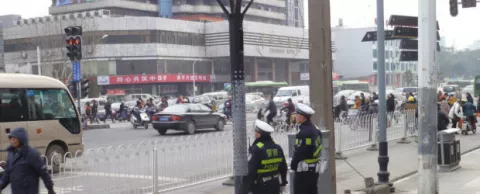
The weak link with traffic signals is often the motorists. Systems can be designed to optimize the flow, but it’s still incumbent upon drivers to do what the lights tell them to do. In one Chinese city where drivers tend to take traffic control into their own hands, a new system mixes the power of networked traffic signals with a visible police presence.
Council Associate Partner Siemens developed the unique hybrid traffic control system, which will soon help alleviate congestion in the Chinese megacity of Wuhan, population 10 million. It combines the authority of a uniformed police officer with the insights of networked traffic lights and road sensors. And it could help in other cities where one or the other simply isn’t enough.
Congestion causes a system breakdown
The idea behind the system is that most motorists have a breaking point. Once congestion reaches a critical level, drivers will start looking out only for themselves. They will begin disregarding the traffic signals and traffic control is simply a matter of the most aggressive driver winning.
While this is a serious problem in Wuhan, it happens on a smaller scale in virtually any big city during rush hour. Imagine that you finally get up to the intersection, but when your light is green there is no room for your car on the street you want to turn on. You may wait, but then your light turns red again. The road clears but then is backed up again before you get another green light. If you’re like most drivers, eventually you’ll decide to drive into the intersection even though there isn’t room for you and block all traffic until you’re finally able to proceed.
If a lot of drivers do this, it isn’t long before nobody is moving. It’s the very definition of gridlock.
Making manual control more effective
Stationing a police officer in the middle of the intersection provides a level of authority that causes drivers to obey the directions, but that scenario is not without its faults. Officers are limited by what they can see. They can’t generally tell what traffic is like two or three intersections away or in other parts of the city.
The Siemens system brings everything together through a smartphone app. An officer can stand in the middle of the intersection and actually control the traffic lights through the app as opposed to being out-of-sight behind a big roadside control panel. That same app also shows real-time data from sensors in other intersections.
To make officers even more effective, the system also uses taxis as traffic sensors. Nearly all of the city’s 20,000 taxis are tracked by GPS. The Siemens system uses their position and speed to assess how traffic is moving overall. And to help make things more fair for drivers at the intersection, the app also shows the directing officer how long each set of cars has been waiting.
Good for the environment too
For cities that have a problem with smog, much of that comes from traffic congestion. Naturally, any system that helps move more cars faster should help alleviate the smog at least somewhat.
The Siemens system, however, could eventually go even further. One day, drivers could also use a version of the smartphone app that would allow them to turn off their vehicles while they are waiting. A message would appear on the app to tell them to turn their cars off when they arrive at the intersection. Another would appear just before it’s time for them to start moving again to tell them to start their vehicle.
The first police officers in Wuhan could be using the app by the end of the year. Before it goes into use, researchers at a Siemens innovation lab in a suburb of Wuhan are still working to add a feature that would show police officers where the traffic jam ends. Because drivers there tend to cut in front of each other constantly in an effort to get ahead, sensors in the roadway aren’t as effective as they need to be. To solve that problem, a team is working to incorporate information from traffic cameras as well.
###
Kevin Ebi is a staff writer and social media coordinator for the Council. Follow@smartccouncil on Twitter.
More traffic resources …
Battling traffic jams with smarter traffic signals
The public health costs of traffic congestion
Will self-driving cars solve your city’s traffic congestion? Survey says not any time soon



